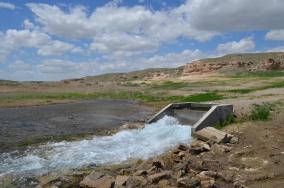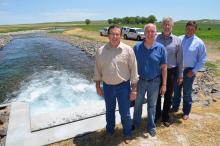Republican River Compact Compliance
Republican River Compact Compliance

The Republican River Compact allocates the average annual water supply of the Republican River among the three states party to the compact that was signed in 1943: 49% to Nebraska; 40% to Kansas; and 11% to Colorado. The amount of water allocated to each state and subject to the percentage splits varies annually depending upon stream flows in Republican River tributaries and the mainstem Republican River.
Before a 2002 settlement agreement between the states, the accounting that determined each state's consumptive water use under the Compact included surface water and alluvial groundwater for irrigation, municipal and industrial uses, and evaporation from Bureau of Reclamation reservoirs. Subsequent to the 2002 settlement agreement, depletions to stream flow caused by all groundwater use including upland wells is included in the calculations. A groundwater model was developed to compute depletions to stream flow caused by groundwater pumping.
Annually, the State of Nebraska, using estimates of surface water supplies and depletions, forecasts whether action will need to be taken in the following year to ensure compliance with the Compact. In cooperation with the state, the URNRD and other NRDs in the Basin have developed action plans and projects designed to maintain Compact compliance. These plans have successfully kept the state in compliance with the Compact since 2006. In 2012, the URNRD completed an approximately $21 million stream flow augmentation project in Dundy County, the Rock Creek Augmentation Project, that significantly enhances the state's and NRDs' ability to maintain compact compliance.
In 2013, the URNRD, Middle Republican NRD, Lower Republican NRD and Twin Platte NRD completed the Nebraska Cooperative Republican Platte Enhancement Project (NCORPE) in Lincoln County. Like the Rock Creek project, the approximately $100 million project involves the retirement of irrigated cropland to rangeland so that water that otherwise would have been used for irrigation can instead be piped into the Republican River to increase stream flow. The two projects have a combined capacity of approximately 85,000 acre feet, and in 2013, 2014, 2015, 2016 and 2017 prevented regulatory compliance actions that would have prohibited farmers from irrigating potentially hunderds of thousands of acres.
Compact compliance has been the subject of significant legal activity since the late 1990's. Most recently, in February 2015, the U.S. Supreme Court made a ruling following Kansas' lawsuit over noncompliance in 2005 and 2006. Kansas had originally requested appointment of a river master that would make regulatory decisions, the permanent shutdown of 300,000-500,000 irrigated acres in Nebraska, and $80 million. The court ruled against a river master, did not impose an irrigation shutdown, and ruled Kansas should receive approximately 7% of it's damages and unjust enrichment request, or approximately $5.5 million. The high court agreed with Nebraska that it had been improperly charged with the consumption of water that seeps into the Republican Basin from the Platte Basin. The crediting change could reduce Nebraska's Compact obligations by approximately 10,000 acre feet annually, Had such a credit been in place from 2013-2015, it would have reduced the Compact demands on Nebraska by approximately 70%.
A new spirit of cooperation between the Compact states has emerged, resulting in agreements intended to benefit water users and managers in each of the states. Specifically, a resolution approved in mid-2016, the "Harlan County Lake Resolution," will help ensure that water that would otherwise be provided by Nebraska at times Kansas didn't need it will instead be provided only when it's determined that the water can be beneficially used by Kansans.
Nebraska Cooperative Republican Platte Enhancement Website and Video




